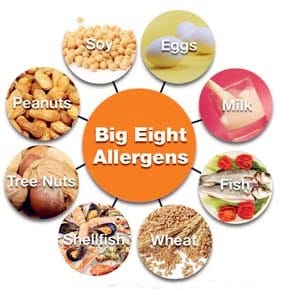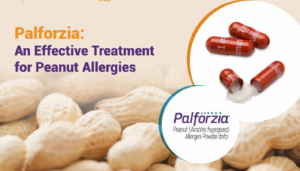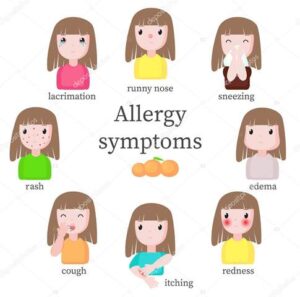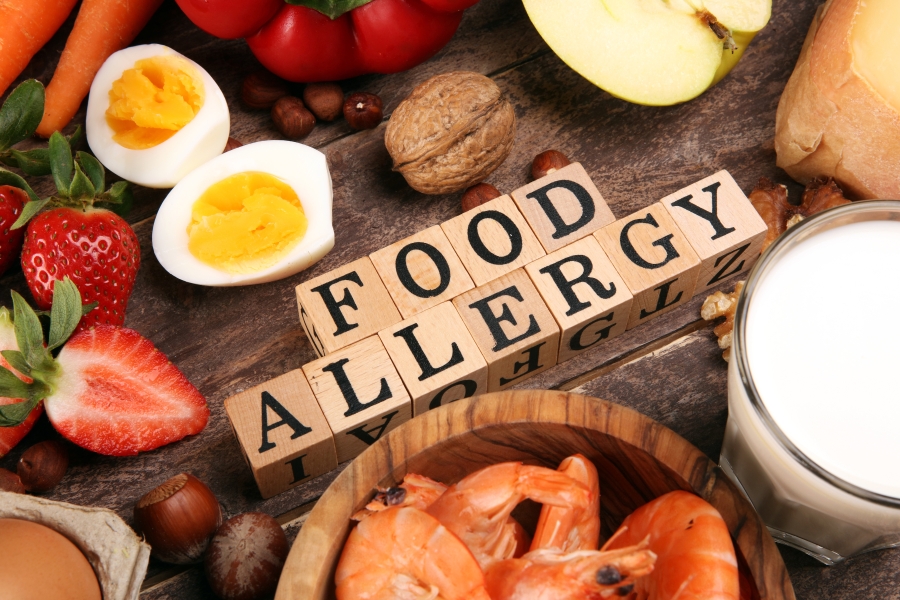Introduction
- Food allergies affect millions of people worldwide, influencing their dietary habits, daily lives, and overall well-being.
- Over the past few years, advancements in research and treatment options have provided new insights into managing and potentially overcoming food allergies.
- This article explores the latest developments, offering a detailed overview of what’s new in the world of food allergies.
What Are Food Allergies?

- Food allergies occur when the immune system mistakenly identifies a specific protein in food as harmful.
- Upon exposure, the immune system triggers a response that can range from mild symptoms, like itching or rashes, to severe reactions such as anaphylaxis, which can be life-threatening.
Key Takeaways
-
Global Prevalence and Rising Cases:
- Food allergies are increasing worldwide, driven by genetics, environmental factors, and dietary habits. Hypotheses like reduced microbial exposure during early life play a role.
- Food allergies are a significant global health concern, with prevalence rates varying across different regions and age groups.
- Below is a table summarizing the latest statistics on the prevalence of food allergies worldwide:
- Variability Across Regions: The prevalence of food allergies varies significantly across different regions and countries, influenced by factors such as genetics, dietary habits, and environmental exposures.
- Age-Related Differences: Children, particularly infants, tend to have higher prevalence rates of food allergies compared to adults.
- Common Allergens: The most prevalent food allergens include cow’s milk, eggs, peanuts, tree nuts, shellfish, fish, soy, and wheat.
- It’s important to note that the methods used to assess food allergy prevalence can impact the reported rates. Studies relying solely on self-reported data may overestimate prevalence compared to those utilizing objective testing methods.
- Frontiers in
- Understanding the global prevalence of food allergies is crucial for developing effective public health strategies, raising awareness, and guiding research efforts aimed at prevention and management.
- Recent Developments in Food Allergy Research
Food & Wine
- There’s a Very Easy Way to Prevent Peanut Allergies, According to a New Study
- 219 days ago

The Times
- Is modern parenting advice fueling allergy epidemic in children?
- 13 days ago
-
Advancements in Treatment:
- Oral Immunotherapy (OIT) is revolutionizing allergy management by building tolerance through gradual exposure to allergens.
- Biological therapies, such as FDA-approved drugs like Palforzia, target specific immune responses, offering promising new treatment options.
-
Enhanced Diagnostics:
- Component-Resolved Diagnostics (CRD) provide precise allergy identification, surpassing traditional tests like skin pricks.
- At-home testing kits are now accessible but should always be supplemented with medical consultation.
-
Improved Lifestyle Management:
- – Stricter food labeling laws and allergen-free products enhance safety for allergy sufferers.
- – Schools and workplaces are adopting robust policies and training to address food allergy emergencies effectively.
-
Early Prevention Strategies:
- Introducing allergenic foods early in infants’ diets, under medical guidance, has shown potential in reducing allergy development risks.

-
Future Research Areas:–
- -Probiotics are being explored for their role in maintaining gut health and mitigating allergic responses.
- -Allergen vaccines under development aim to provide long-term immunity and prevention.
-
Social and Emotional Support:
- Awareness campaigns, community education, and support groups play vital roles in managing the emotional and social impact of food allergies.
-
Call to Action:
- Increased public awareness, continued research, and better access to new treatments can significantly improve outcomes for individuals with food allergies.
Common Food Allergens
- The most common food allergens, often referred to as the “Big Eight,” include:
- – Milk See Post: https://healthinfo.site/lactose-intolerance-and-its-impact/
- -Eggs
- – Peanuts
- – Tree nuts (e.g., almonds, walnuts)
- – Fish
- – Shellfish
- – Wheat
- – Soy
- Other emerging allergens include sesame and certain seeds, which have gained recognition due to increasing reports of allergic reactions.
- A gluten allergy (often referred to as gluten intolerance or celiac disease) requires avoiding all foods containing wheat or gluten, even in small quantities. Here’s why:
1. Understanding Gluten Allergy vs. Celiac Disease vs. Gluten Sensitivity
- Wheat Allergy:
- An immune reaction to proteins in wheat, not specifically gluten.
- Requires avoiding wheat but may tolerate other gluten-containing grains like barley or rye (consult your doctor for specifics).
- Small amounts of wheat may trigger mild to severe allergic symptoms.
- Celiac Disease:
- A severe autoimmune condition where even tiny amounts of gluten (a protein in wheat, barley, and rye) cause damage to the small intestine.
- Requires complete elimination of all gluten-containing foods.
- Non-Celiac Gluten Sensitivity (NCGS):
- Symptoms triggered by gluten without the autoimmune response seen in celiac disease.
- Gluten reduction may help, but it’s not as strictly required as for celiac disease.
2. Why Even Small Quantities of Wheat or Gluten Matter
- For people with celiac disease, even trace amounts of gluten can lead to intestinal damage, even if symptoms are not noticeable.
- For wheat allergy, even small exposures can trigger an allergic reaction ranging from mild itching to severe anaphylaxis.
- Gluten-containing ingredients are often “hidden” in processed foods, so careful label reading is essential.
3. What to Avoid
If you are avoiding wheat or gluten, here’s what to steer clear of:
- Foods containing wheat or wheat derivatives: Bread, pasta, cereals, baked goods, sauces, and soups thickened with wheat.
- Hidden gluten sources: Soy sauce, gravies, dressings, processed meats, and even some medications and supplements.
4. Low-Quantity Wheat Products
- Unfortunately, for celiac disease and wheat allergy, there’s no “safe” level of wheat or gluten. Even minimal exposure can cause harm. If you are gluten-sensitive (not celiac or allergic), some individuals may tolerate small amounts of wheat or gluten occasionally, but this should be discussed with a healthcare provider.
5. Gluten-Free Alternatives
Fortunately, there are many alternatives to wheat and gluten-containing products:
- Gluten-Free Grains: Rice, quinoa, millet, buckwheat, sorghum, and amaranth.
- Certified Gluten-Free Products: Look for labels that confirm they meet strict standards for gluten-free safety.
- Flours: Almond, coconut, chickpea, tapioca, and potato flours are excellent for gluten-free cooking and baking.
- If you have been diagnosed with a gluten allergy (e.g., wheat allergy, celiac disease), it is safest to avoid all wheat-containing foods, even those with small quantities of wheat or gluten.
- For personalized guidance, consult a healthcare provider or dietitian specializing in food allergies or celiac disease.
What’s New in Food Allergy Research?

Understanding Food Allergy Prevalence
- Recent studies show an increase in the prevalence of food allergies globally.
- Factors such as genetics, environmental exposures, and changes in dietary habits contribute to this rise.
- Interestingly, the “hygiene hypothesis” suggests that reduced exposure to microbes in early life might play a role in the increasing cases of allergies.
Oral Immunotherapy (OIT)
- Oral immunotherapy (OIT) has been a game-changer in food allergy management.
- This treatment involves gradually introducing small amounts of the allergenic food to build tolerance over time.
- For instance, in peanut allergies, OIT has shown significant success in reducing the severity of reactions and improving quality of life.

Key Advantages:
- – Increased tolerance levels
- – Reduced anxiety around accidental exposures
- – Promising results for children and adolescents
Biologics and Medications
- Biological therapies, such as monoclonal antibodies, have opened new avenues for treating food allergies.
- Palforzia, the first FDA-approved drug for peanut allergies, helps desensitize individuals aged 4-17 to peanuts.
- Other drugs targeting IgE (the antibody responsible for allergic reactions) are under development.
Food Allergy Diagnosis: Advances in Testing
Component-Resolved Diagnostics (CRD)
- Traditional allergy tests, like skin prick tests, have limitations.
- Component-resolved diagnostics (CRD) provide more precise insights by identifying specific proteins responsible for allergic reactions.
- This allows tailored treatment plans for individuals.
At-Home Testing Kits
- The rise of at-home allergy testing kits has made it easier for individuals to screen potential food sensitivities. While these kits are convenient, they should complement, not replace, professional medical advice.
Managing Food Allergies in Daily Life
Improved Food Labeling
- Governments worldwide are strengthening food labeling regulations.
- For instance, the inclusion of sesame as a major allergen in the U.S. food labeling laws helps individuals make safer dietary choices.
- Clearer labels reduce the risk of accidental exposure.
Allergen-Free Food Products
- The food industry is responding to consumer needs by introducing allergen-free alternatives. From nut-free spreads to gluten-free snacks, these products provide safe options without compromising taste.
Schools and Workplaces
- Increasing awareness has led to the implementation of stricter food allergy policies in schools and workplaces. Education programs and emergency response training ensure safer environments for individuals with allergies.
Promising Research Areas
Early Introduction of Allergens
- Studies like the LEAP (Learning Early About Peanut) trial suggest that introducing allergenic foods to infants at an early age can reduce the likelihood of developing allergies.
- Pediatricians now recommend incorporating small amounts of allergenic foods into a baby’s diet after consulting a healthcare provider.
Probiotics and Gut Health
- Emerging evidence links gut health to allergy development. Probiotic treatments aim to restore a healthy gut microbiome, potentially reducing allergic responses. While still under research, this approach shows promise as a supplementary therapy.
Allergen Vaccines
- Scientists are working on vaccines to prevent allergic reactions entirely. These vaccines target the immune system, retraining it to tolerate allergens without triggering a response.
Living with Food Allergies: Emotional and Social Support
Coping Mechanisms
- Living with food allergies can be stressful, especially for children and their families.
- Support groups, counseling, and educational workshops help individuals navigate the challenges and reduce anxiety around food.
Educating Others
- Raising awareness about food allergies among peers, coworkers, and the community fosters understanding and inclusivity.
- Simple actions, such as avoiding cross-contamination and respecting dietary restrictions, make a significant difference.
Conclusion
- Food allergies remain a significant global health concern, but advancements in research and treatment offer hope for better management and prevention.
- From innovative therapies like OIT to breakthroughs in diagnostics and allergen labeling, the landscape of food allergy care is evolving rapidly.
- As awareness grows, living with food allergies becomes more manageable, empowering individuals to lead safer, healthier lives.
Frequently Asked Questions (FAQs)
-
What are the most common food allergens?
- The “Big Eight” allergens include milk, eggs, peanuts, tree nuts, fish, shellfish, wheat, and soy. Sesame is also gaining recognition as a common allergen.
-
Can food allergies be cured?
- Currently, there is no definitive cure for food allergies. However, treatments like oral immunotherapy and biological therapies can help manage and reduce symptoms.
-
Is there a way to prevent food allergies in children?
- Early introduction of allergenic foods, under medical supervision, may reduce the risk of developing allergies in some children.
To prevent food allergies, you can:
-
Communicate
: Let people know what your allergy is, how severe it is, and that even trace amounts can cause harmful effects
-
Wash utensils
: Wash all your utensils and cutting boards with soap and water before and after use
-
Carry medications
:Always carry your medications, such as an EpiPen or antihistamines
-
How can I identify a food allergy?

- Some common symptoms include: an itchy sensation inside the mouth, throat or ears. a raised itchy red rash (urticaria, or “hives”) swelling of the face, around the eyes, lips, tongue and roof of the mouth (angioedema) and gastrointestinal issues.
- Diagnosis involves skin prick tests, blood tests, or component-resolved diagnostics (CRD).
-
What should I do during a severe allergic reaction?
- Administer an epinephrine auto-injector immediately and seek emergency medical attention. It’s crucial to act quickly to prevent complications.
-
Are food allergies the same as food intolerances?
- No. Food allergies involve the immune system, while food intolerances are related to the digestive system and do not trigger severe immune responses.
References:
- American Academy of Allergy, Asthma & Immunology (AAAAI)
- Provides up-to-date information on food allergy prevalence, diagnosis, and management, including oral immunotherapy (OIT) and component-resolved diagnostics.
Website: (https://www.aaaai.org)
- National Institute of Allergy and Infectious Diseases (NIAID)
- Discusses federal research initiatives on food allergies, including clinical trials for immunotherapies and vaccines.
Website: (https://www.niaid.nih.gov)
- Food Allergy Research & Education (FARE)
- Covers resources on managing food allergies, including food labeling laws, allergen-free products, and emotional support for individuals and families.
Website: (https://www.foodallergy.org)
- The LEAP Study (Learning Early About Peanut Allergy)
- Landmark study on early peanut introduction in infants to prevent allergies. Published in the New England Journal of Medicine.
Reference: [https://www.nejm.org/doi/full/10.1056/NEJMoa1414850]
- U.S. Food and Drug Administration (FDA)
- Details FDA-approved treatments like Palforzia and updates on biologics targeting food allergies.
Website: (https://www.fda.gov)
- Mayo Clinic: Food Allergies Overview
- Provides patient-friendly explanations of symptoms, causes, and the latest treatment advancements, including dietary management.
Website: (https://www.mayoclinic.org)


Recently got to know that i have lactose intolerance, my symptoms were very atypical and lead to a delayed diagnosis…was searching for relevant topics n landed here. Very informative indeed 💯 …hope to see more information on lactose intolerance and its relation to skin issues…
Lactose Intolerance is rarely seen in adult population. It is mainly the issue of Pediatric age group where we come across kids having prolog history of Diarrhea. Diarrhea washes out the jejunal epithelial lining which is the source of Lactase enzyme leading to Lactose Intolerance. Of course, we are working on this topic and soon you’ll find detailed information with its association to skin problems.
Wheat allergy I mean gluten allergy prevents every typr of food containing wheat or we can have something with low quamtity of wheat?
If you have been diagnosed with a gluten allergy (e.g., wheat allergy, celiac disease), it is safest to avoid all wheat-containing foods, even those with small quantities of wheat or gluten. For personalized guidance, consult a healthcare provider or dietitian specializing in food allergies or celiac disease.
If someone is having milk allergy he cannot eat anything made from milk. Is this true?
Yes, it is generally true that someone with a milk allergy should avoid all foods and products that contain milk or milk-derived ingredients. Milk allergy occurs when the body’s immune system mistakenly identifies proteins in milk (such as casein or whey) as harmful, triggering an allergic reaction.
Here are a few important points to consider:
1. Foods to avoid: This includes milk itself, dairy products like cheese, yogurt, butter, cream, and ice cream, and foods that contain milk as an ingredient (e.g., baked goods, processed foods, sauces, or salad dressings).
2. Hidden sources of milk: Milk can be found in unexpected places, such as in processed foods, candies, and even non-food products like lotions or soaps. It’s important for individuals with a milk allergy to read ingredient labels carefully.
3. Cross-contamination: Even trace amounts of milk can cause a reaction. Therefore, people with a milk allergy need to be cautious about cross-contact with milk during food preparation or eating out.
4. Milk alternatives: People with milk allergies often use plant-based alternatives, such as almond milk, soy milk, oat milk, or coconut milk, which do not contain dairy.
So, while it’s possible to find milk-free products, individuals with milk allergies must be vigilant and avoid anything that contains milk or its derivatives. Always check labels and ask about food preparation if eating outside the home.
Thanks for sharing. I read many of your blog posts, cool, your blog is very good.
I don’t think the title of your article matches the content lol. Just kidding, mainly because I had some doubts after reading the article.
Your point of view caught my eye and was very interesting. Thanks. I have a question for you.
Thanks for sharing. I read many of your blog posts, cool, your blog is very good.
Can you be more specific about the content of your article? After reading it, I still have some doubts. Hope you can help me.
Thank you for your sharing. I am worried that I lack creative ideas. It is your article that makes me full of hope. Thank you. But, I have a question, can you help me?
Thanks for sharing. I read many of your blog posts, cool, your blog is very good.
Thanks for sharing. I read many of your blog posts, cool, your blog is very good.
Your article helped me a lot, is there any more related content? Thanks!
Your article helped me a lot, is there any more related content? Thanks!
Your point of view caught my eye and was very interesting. Thanks. I have a question for you.
Thank you for your sharing. I am worried that I lack creative ideas. It is your article that makes me full of hope. Thank you. But, I have a question, can you help me?
Thanks for sharing. I read many of your blog posts, cool, your blog is very good.
Your point of view caught my eye and was very interesting. Thanks. I have a question for you.
I don’t think the title of your article matches the content lol. Just kidding, mainly because I had some doubts after reading the article.
Your article helped me a lot, is there any more related content? Thanks!
Your point of view caught my eye and was very interesting. Thanks. I have a question for you.
Can you be more specific about the content of your article? After reading it, I still have some doubts. Hope you can help me.
Thanks for sharing. I read many of your blog posts, cool, your blog is very good.
Your article helped me a lot, is there any more related content? Thanks!
I don’t think the title of your article matches the content lol. Just kidding, mainly because I had some doubts after reading the article.
Your article helped me a lot, is there any more related content? Thanks!
Can you be more specific about the content of your article? After reading it, I still have some doubts. Hope you can help me.
Your enticle helped me a lot, is there any more related content? Thanks!
Your article helped me a lot, is there any more related content? Thanks!